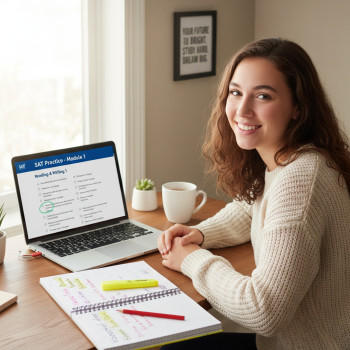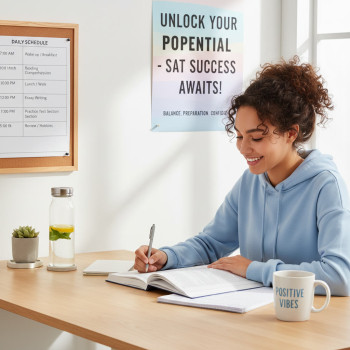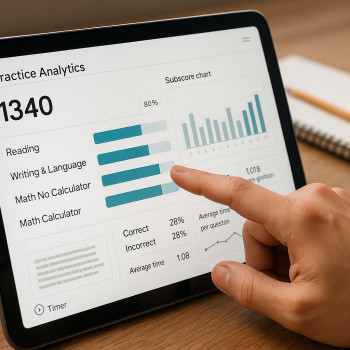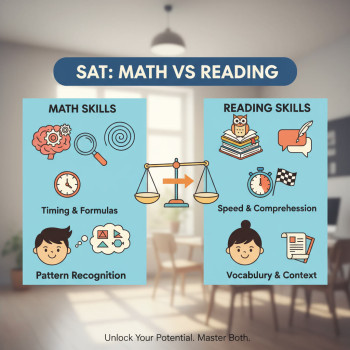Welcome to the Digital Era: Why Your Study Style Needs an Update
If you’ve been prepping for the SAT with pencil-scratch practice tests and stacks of printouts, pause for a second. The Digital SAT isn’t just the same test on a tablet — it’s a shift in format, timing, and how the experience unfolds for you on test day. That means your prep needs to shift too. This post walks you through what changed, why it matters, and how to adapt your study style so you’re not simply translating old habits to a new device but building a smarter, more efficient approach that fits the test and your brain.
Big Picture Changes—and What They Mean for You
The Digital SAT introduces several important differences: shorter sections, an adaptive structure across modules, an on-screen Desmos calculator, and an app-based delivery (Bluebook). These create new opportunities and challenges. Let’s unpack the ones that matter most to your prep.
Shorter modules, sharper focus
Rather than a few long sections, the Digital SAT is delivered in shorter modules. That changes mental pacing: you’ll face more frequent task-switching and need to re-center quickly between modules. For many students, shorter modules feel less exhausting—but they also leave less time to “ease in” mid-section. Practicing short, intense bursts of focused work helps: simulate the module length during practice and learn how to start strong immediately.
Adaptive testing: strategy over endurance
Parts of the Digital SAT are adaptive, which means the difficulty of later modules can depend on how you perform earlier. That makes accuracy in early questions more valuable than ever. Instead of assuming a gradual warm-up, treat early module questions like they set the tone for what comes next. Practically, that means prioritizing accuracy and efficient thinking on the first questions of each module.
On-screen calculator and tools
The embedded Desmos calculator (plus the option to use an approved handheld non-CAS calculator) changes the way you approach math problems. You can graph quickly, test hypotheses numerically, and use features that would be slow or messy on paper. But the on-screen tool can also be slower if you’re unfamiliar with its shortcuts. Practicing with the same tools under timed conditions is essential—learn the Desmos layout, the keyboard/mouse shortcuts, and when it’s faster to do algebra by hand versus using the calculator.
Digital interface and technical etiquette
Test delivery through an app introduces practical differences: you’ll navigate screens, follow app prompts, and occasionally recover from small technical hiccups. Becoming comfortable with the test interface reduces cognitive load on exam day, so you can focus on questions—not on how to highlight or flag an item.
Designing a Digital-First Study Plan
Once you understand those changes, create a plan built around the digital experience. The foundation: practice with the actual format, build module-focused stamina, and sharpen accuracy early in modules. Below is a week-by-week sample plan you can adapt depending on how many months remain before your test.
Sample 12-week plan — digital-first
| Weeks | Focus | Weekly Routine |
|---|---|---|
| 1–2 | Baseline & Familiarization |
|
| 3–6 | Core Skills + Module Practice |
|
| 7–9 | Strategy and Timing |
|
| 10–11 | Polish & Simulation |
|
| 12 | Taper & Confidence |
|
How to turn practice into progress
Practice alone won’t move the needle—you need high-quality review. After each practice module or test, spend at least twice the test time reviewing errors and thinking strategically about why mistakes happened. Were they content gaps, careless slips, or timing/format issues? Tag each error and build micro-lessons to address them.
Concrete Strategies for Each Section
Adapting your prep also means tailoring techniques to each section’s quirks. Here’s a practical checklist for Reading & Writing and Math.
Reading & Writing: read smarter, not longer
- Prioritize early-question clarity. Since modules can be adaptive, aim for accuracy on the first questions to set the right difficulty path.
- Practice digital annotation. On paper you might underline and margin-note—on the screen, develop shorthand and visual scanning techniques (highlight key sentences, track tone or shift markers mentally).
- Embrace active reading: summarize each paragraph in two words and use that mental tag to navigate the passage when questions ask about detail or purpose.
- Timing tip: if a passage feels dense, read the first and last paragraphs and the topic sentence of each middle paragraph before answering. Then return to passage details as needed.
Math: choose the right tool—on-screen or handheld
- Know when Desmos shines: graphing, curve sketching, and testing complex expressions are faster on Desmos.
- Know when paper wins: tidy algebraic manipulation and step-by-step work can be clearer by hand. Practice switching between on-screen and paper work quickly.
- Practice the mechanics of inputting expressions: build muscle memory for common operations (exponents, fractions, solving equations) to save time.
- Accuracy-first in early module questions—one correct early answer helps place you advantageously for later, higher-difficulty items.
Common mistakes students make with the digital tools
- Over-relying on the calculator for simple arithmetic and losing time.
- Mis-clicks or mis-entry of equations in Desmos due to unfamiliarity.
- Not using the built-in flagging or review features smartly—learn the app’s shortcut for marking questions to revisit quickly.
Daily and Weekly Routines That Actually Work
Consistency is more important than marathon study sessions. Make your schedule realistic and varied so your brain stays engaged. Here’s a practical weekly template you can adapt.
Weekly template (6-hour week example)
- 2 hours: Focused content drills (30–40 minute sessions on specific algebra, grammar rules, or vocabulary in context).
- 2 hours: Module-style practice (short, timed module blocks on the interface you’ll use for testing).
- 1 hour: Deep review—go over errors, make notes, and create two micro-lessons (one grammar rule, one math trick).
- 1 hour: Test strategy—timing drills, practice managing the app, or targeted practice with the on-screen calculator.
Micro-lessons and error journals
Every week, create two micro-lessons from your error log: a 5–8 minute “how-to” fix for a grammar rule or math technique you missed. Keep an error journal where each entry includes the problem, the mistake type, and the correction. Over time you’ll see patterns worth adjusting in your study plan.
Simulation and Test-Day Logistics
Simulation is the secret sauce. The Digital SAT has unique logistics—Bluebook app behavior, the on-screen calculator, and timing—that deserve rehearsal. Simulate not just content but the logistics: the exact device, seating posture, headphones if allowed for accommodations, and your test-day checklist.
Test-day checklist
- Fully charge the device you’ll use for practice so you’re not surprised by battery behavior during long blocks.
- Practice signing in and navigating the Bluebook-style app. Learn how to flag questions and how to pause and resume (practice the app’s flow).
- Prepare your approved handheld calculator (if you plan to bring one). Verify it is non-CAS and has no stored programs that violate rules.
- Pack snacks, water, ID, allowed calculator, extra batteries, and any accommodation documentation the school requires.
Mindset: From Panic to Performance
The digital shift can feel like a curveball. The best competitive advantage isn’t memorizing obscure facts but building a calm, adaptable test-day mindset. Use pre-test routines: short breathing, 2-minute visualization of starting confidently, and a checklist ritual that turns anxiety into focus.
What to do the night before
- Light review only—no heavy content drilling. A short, confidence-building practice module is fine.
- Lay out everything you’ll bring. Confirm testing window, start time, and travel logistics.
- Sleep. Sleep more than you think you need; reaction time and focus are fragile without it.
How Personalized Tutoring Fits—Smart, Not Salesy
One of the smartest ways to accelerate is to get personalized guidance—especially when the format itself is new. Personalized tutoring, like Sparkl’s 1-on-1 guidance, can be a natural fit because it tailors study plans to the digital format: targeted module practice, coach-led Desmos walkthroughs, adaptive strategy coaching, and AI-driven insights that highlight which module questions are costing you most. When you’re learning new test mechanics and high-leverage content at the same time, an expert tutor can help you bundle those gains efficiently.
What to expect from a well-designed tutoring partnership
- A tailored study plan that matches your schedule and prioritizes the digital skills you need.
- 1-on-1 sessions that model the test interface, practice with the on-screen calculator, and simulate adaptive strategy choices.
- Actionable feedback after every practice test and micro-lessons to plug gaps quickly.
Tracking Progress: Metrics That Matter
When you’re adapting to a new format, track the right signals. Raw score is important, but the underlying data tells a fuller story.
Progress dashboard: what to measure weekly
| Metric | Why it matters | Target |
|---|---|---|
| Module accuracy (first 5 questions) | Influences adaptive path and later difficulty. | 80%+ |
| Average time per question | Helps diagnose pace vs. depth issues. | Within target range from timed practice |
| Error type breakdown | Shows whether mistakes are careless, conceptual, or interface-related. | Reduction in repeat error types over 4 weeks |
| Comfort with digital tools | Confidence using Desmos and navigation reduces wasted time. | High—no task takes more than a few extra seconds due to unfamiliarity |
Real-World Examples and Quick Wins
To make this concrete, here are a few quick wins students report after shifting their prep style.
Quick Win #1: The Early-Question Shift
A student who used to warm up slowly changed tactics: she practiced answering the first three questions of every module with extra care and slowed on purpose to ensure accuracy. Her adaptive path shifted upward more often, giving her stronger later questions where she could rack up points. The result: a noticeable score jump after two months, with less test-day stress because the early wins built momentum.
Quick Win #2: Desmos shortcut mastery
Another student practiced common Desmos commands and learned to toggle between equation and table views fast. For problems that would have taken multiple pages to graph by hand, he solved them in a minute on screen—saving time for tougher algebra later.
Quick Win #3: Simulated tech hiccup recovery
Simulating a short app exit and resume during practice helped a student avoid panic when a real, brief disconnection happened on test day. Because he’d rehearsed the flow, he resumed calmly and didn’t lose focus—simple rehearsal erased a big potential distraction.
When to Get Extra Help
Consider supplemental help if any of the following are true:
- You plateau despite consistent practice and targeted review.
- You feel stuck on adapting to the digital tools or adaptive strategy.
- Your schedule is tight and you want an efficient plan that minimizes wasted practice time.
Personalized tutoring (for example, Sparkl’s 1-on-1 approach) can be particularly helpful because a tutor can pinpoint whether the issue is content mastery, pacing, or unfamiliarity with the digital interface—and then prioritize the highest-leverage interventions.
Final Checklist: Top 10 Digital SAT Prep Actions
- Take one full digital practice test to establish a baseline and identify interface issues.
- Practice module-length blocks instead of always doing long sections on paper.
- Train to be accurate on the first questions of each module—this matters for adaptive routing.
- Learn the Desmos calculator and practice quick graphing/input techniques.
- Keep an error journal and create weekly micro-lessons from recurring mistakes.
- Simulate test-day logistics, including app sign-in, device behavior, and breaks.
- Build a steady weekly routine that mixes content, strategy, and simulation.
- Practice recovery from small technical interruptions to avoid panic on test day.
- Consider targeted 1-on-1 tutoring if you need faster, tailored progress—especially to master the new format.
- Rest, sleep, and maintain a consistent pre-test ritual; mental stamina is a skill you build.
Parting Thought: Adaptability Is Your Superpower
The move to digital is less about being intimidated by technology and more about being adaptive in how you prepare. The students who do best are the ones who treat the format as part of the test strategy—rehearsing the app, the calculator, and the module flow—while continuing to sharpen the underlying skills that always matter: clear reading, logical reasoning, and precise math work. With deliberate practice, smart simulation, and occasional expert guidance (whether from a coach, teacher, or personalized tutoring like Sparkl’s tailored 1-on-1 plans), you can turn the Digital SAT from an unknown into an advantage.
Ready to start?
Pick one small change from this guide—learn a Desmos shortcut, take a module-only timed drill, or simulate a full digital test this weekend. Small, consistent shifts add up faster than you think. Good luck—and remember: adapting your prep style is the skill that will serve you far beyond this one exam.















No Comments
Leave a comment Cancel